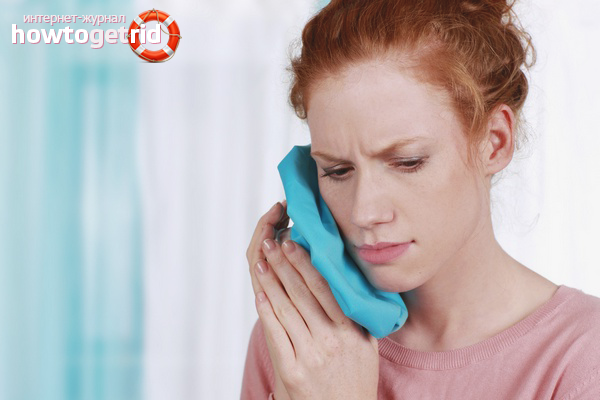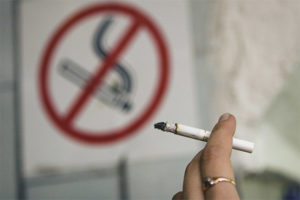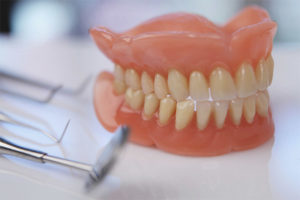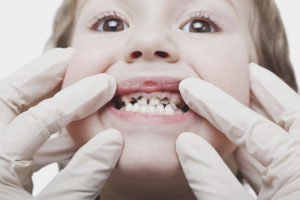The content of the article
Removing a wisdom tooth is carried out in several stages. On the first patient, an x-ray is taken and the location of the roots is determined. At the second, the gum is cut, the upper part is pulled out with forceps and the resulting hole is cleaned of debris. The third stage is the care of the oral cavity at home. The patient should regularly treat the wound and disinfect the oral cavity, follow the doctor’s instructions and diet so that the gums can be tightened quickly without serious complications.
Day one: general recommendations
The dentist closes the resulting hole with a cotton swab. It is held for 20-30 minutes, and then taken out. Clotted blood accumulates inside the wound, which acts as a barrier that protects against germs and bacteria. This cork should not be touched with fingers or tongue, scratched with a toothbrush or other objects.
The hole will be delayed and stop bleeding in 2-3 hours. During this period, you can not eat food or drinks. On the first or second day after the removal of the wisdom tooth, it is recommended to abandon raw vegetables and fruits. Cook mashed soups or mucous porridge, and meat and fish, cleaned of bones, beat in a blender with a small amount of broth. Particulate matter traumatizes the hole remaining from the third molar and can cause bleeding.
Dishes should be warm. Jelly, chewing gums and other sticky products are contraindicated. Sour-milk drinks can be introduced into the diet, but they must be warmed up to room temperature.
It is advisable to eat food through a tube or with a teaspoon. The patient should not open his mouth wide so that the stitches do not open. Chew the healthy side so that less germs and food debris get into the hole.
On the first day after surgery, it is better to stay home and avoid stressful situations. It’s good to sleep a lot. The body recovers faster precisely during rest. Do not take a hot bath or visit the bath in the first week after removal of the third molar. High temperatures can trigger bleeding that only the dentist will stop.
The patient is advised to refrain from evening brushing. But in the morning, be sure to treat the oral cavity. Only the brush should not touch the blood clot and the hole, because the gum is easy to injure. And bring an infection, provoking inflammation and suppuration of soft tissues.
Pain and temperature
The action of the anesthetic gradually decreases, and uncomfortable sensations appear in the region of the third molar. They intensify, preventing the patient from sleeping and eating. Pain is a normal reaction to removing a wisdom tooth, but it is not necessary to endure.
The dentist who performs the operation should choose drugs that remove the discomfort. If the doctor forgot to make a list of painkillers, you can try Ketanov, Baralgin or Tempalgin. But take no more than 3 tablets per day. Abuse of potent drugs is fraught with tachycardia, pain in the stomach, problems with the nervous system and pressure.
On the second or third day after the operation, when the blood clot dries a little, a piece of garlic can be applied to the hole. Spiced vegetables, peeled, cut into thin plates and pressed to the gums. Or squeeze juice from the workpiece and soak a gauze swab with home medicine.
Garlic is an antiseptic and pain reliever in one bottle. The product kills bacteria, reducing the likelihood of inflammation, and stimulates the healing of the hole.But compresses from a spicy vegetable are applied no more than 3 times a day and hold for 10 to 15 minutes so that the product does not burn the delicate mucous membrane of the gums.
The pain is removed with cold compresses. Hot contraindicated. Warm lotions enhance swelling and blood circulation in the hole. Cold freeze nerve endings and dull discomfort. The compress is made from ice cubes or a piece of meat lying in the freezer. The product is wrapped with cling film and a small terry towel. The fabric will protect your face from frostbite.
Cold compresses are used 3-4 times a day. Lotions are applied for 20-30 minutes, but you can’t hold them for longer, otherwise the capillaries located in the gums will become brittle and brittle. The risk of bleeding will increase.
In the first days after surgery, the patient complains not only of pain, but also of high fever. Indicators 37.6–38, 5 are considered normal. If the level of the thermometer smoothly approaches 39 or even 40, then you need to call the dentist or call an ambulance.
At home, the heat is brought down by heavy drinking. Only hot teas and decoctions are prohibited. Warm drinks are replaced with still water, natural juices and chilled fruit drinks. It is worth giving up sweet soda and jelly. Sugar settles on a blood clot covering the hole, and creates ideal conditions for the reproduction of microbes. But bacteria cause inflammation and increase fever.
The temperature is lowered by Ibuprofen, Nurofen or Nise. The drugs have analgesic properties. Also, in case of heat after removal of a wisdom tooth, Paracetamol and Nimesil are recommended. Tablets are taken after 6-8 hours, not more often. If the temperature does not drop, you should consult your doctor.
Disinfecting procedures
Improper care of a fresh wound leads to complications and serious diseases:
- alveolitis;
- stomatitis;
- hematomas;
- osteomyelitis of the jaw;
- purulent periodontitis;
- abscesses.
In order for the hole to drag out quickly and without problems, the patient should give up heavy physical exertion for 1-2 weeks. You can not lift heavy bags, buckets and go to the gym. Even morning exercises in the early days are contraindicated.
The risk of complications is increased due to smoking. Hot smoke dissolves the blood clot, so it can fall ahead of time. There will remain an open wound into which infections and bacteria will penetrate.
It is impossible to rinse the oral cavity, but you can make disinfectant baths. Disinfecting compounds are prepared from medicinal plants:
- daisies;
- oak bark;
- calendula
- eucalyptus;
- sage.
Herbs not only destroy microbes, but also stop inflammation. They also stimulate the regeneration of soft tissues and dull the pain. Decoctions are prepared from 2-3 tbsp. l healing raw materials and a cup of water. Plants are either steamed with boiling water or use a water bath. Solutions for oral disinfection cool down to 35–36 degrees and must be filtered through gauze, folded in 7–8 layers. The main thing is that there should not be small particles in the infusion that can get stuck in the hole.
Antiseptics for washing the wells are prepared from baking soda. For 300 ml of chilled boiled water, 35–40 g of powder. Plus 5-6 drops of iodine or alcohol tincture of calendula. You can use Chlorophyllipt, but not necessarily. Soda composition is also filtered through cheesecloth.
The third version of the antiseptic is prepared from table or iodized salt. The spice kills germs, and also burns the edges of a fresh wound, reducing the chance of bleeding. The solution should not be too concentrated, so 25-30 g of salt are taken on a cup of liquid. Stir until the crystals of seasoning are completely dissolved, and then filter to prevent solid particles from injuring the gums.
A patient about to remove a wisdom tooth may purchase Miramistin or Chlorhexidine in advance. The second option is practically no different from the first, but costs two to three times cheaper.Pharmacy antiseptics are used to disinfect the oral cavity 3-4 hours after surgery.
So that the solution does not wash the blood clot, you need to collect the product in your mouth and slowly “pour” it onto the sick side. Keep the antiseptic for 5 to 15 minutes, and then gently spit it out. The procedure is repeated 4-5 times a day.
Bleeding has opened
At home, a swab of sterile gauze is pressed against the wound. Cotton wool does not fit, particles of material stick to the gum and remain in the open hole. The tampon is pressed with teeth. The workpiece can be moistened in a solution of soda with iodine or in “Chlorhexidine”. Before the operation, you can buy hemostatic tablets "Vikasol" or "Dicinon". But the drugs must be approved by the doctor, because they are not suitable for all patients. If the bleeding does not decrease within 5-10 minutes, call an ambulance.
Alarming symptoms
Edema appears on the first day after removal of the third molar. On 2-3 days it should decrease. If the cheek is swollen, and the body temperature is kept within 37–39 degrees, you need to make an appointment with the doctor.
A dentist consultation is needed if the patient has:
- headache;
- inflammation of the lymph nodes located next to the wisdom tooth;
- numbness of the lower part of the face or gums;
- unpleasant odor indicating rotting;
- throbbing pain affecting the lower jaw and ear.
A person with complications opens the gum. Purulent contents are removed and the well is washed with antiseptic solutions. And then antibiotics are prescribed to prevent re-inflammation. Only a dentist or maxillofacial surgeon should carry out manipulations and select drugs. It is forbidden to take out a blood clot and pierce abscesses at home.
There are many nerve endings, lymphatic vessels and blood capillaries in the wisdom teeth, so the removal of the third molar is often accompanied by pain, swelling and fever. But the symptoms disappear on the 3rd – 6th day, if a person follows the doctor’s recommendations, does not forget to take the prescribed drugs and carefully looks after the oral cavity.
Video: recommendations after tooth extraction











Submit